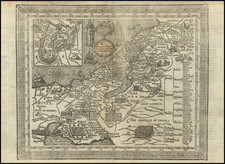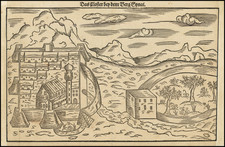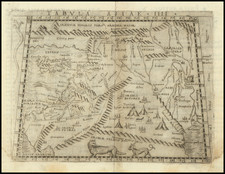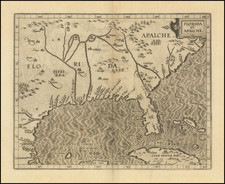Noah's Ark After The Flood -- The Procession of Animals
The Noah's Ark, apparently landing in Florida, with a procession of animals departing the ark.
The engravings published by Theodor de Bry in his Grand Voyages (1591), based upon watercolor illustrations made by Jacques Le Moyne de Morgues, are the earliest known European depictions of Native Americans in what is now known as the United States. Le Moyne, a member of the short-lived French colony known as Fort Caroline founded by Huguenot explorer Rene Goulaine de Laudonniere (ca. 1529-1574), based the watercolors on his experiences in Florida in the 1560s. De Bry later published Le Moyne's work, along with other illustrations of the New World, as part of an effort to encourage European colonization in the Americas. Jacques le Moyne de Morgues, an illustrator and explorer, sailed with René de Laudonnière on the 1564 Huguenot expedition to Florida. Laudonnière set up Fort Caroline on the St. John's River in 1564, but the settlement was destroyed by the Spanish army under Pedro Menendez de Aviles.
This work was originally produced by Theodore de Bry in his important travel book the Grands Voyages.
This image accompanied the Latin text that follows which seems to suggest that it is here to illustrate how the inhabitants of Florida and Virginia descended from Ham. It was common for De Bry to use generic images to accompany some of his text so he could reuse the same woodblock several times.
Do not think, good reader, of Virginia, which we made a few months ago; although, to confess the truth, this circumstance also greatly affects the minds; but rather, as you observe the immense and wonderful works of God, let us give thanks to him for the kindness he received, that he deigned to reveal himself to us, and teach us the way of salvation, when we observe these wretched Florida The inhabitants of the neighboring Provinces (who, however, undoubtedly originated from one of the sons of Noah, but from Ham, as it is credible, than from any of the rest), were ignorant of the knowledge of God. Otherwise, of course, they were presented with an elegant symmetry of body, great, robust, daring, agile, yet supremely stubborn and insidious. They have a lurid and dirty color, which, after anointing the body with a certain oil, they contract with the heat of the sun;
Theodor de Bry (1528-1598) was a prominent Flemish engraver and publisher best known for his engravings of the New World. Born in Liege, de Bry hailed from the portion of Flanders then controlled by Spain. The de Brys were a family of jewelers and engravers, and young Theodor was trained in those artisanal trades.
As a Lutheran, however, his life and livelihood were threatened when the Spanish Inquisition cracked down on non-Catholics. De Bry was banished and his goods seized in 1570. He fled to Strasbourg, where he studied under the Huguenot engraver Etienne Delaune. He also traveled to Antwerp, London, and Frankfurt, where he settled with his family.
In 1590, de Bry began to publish his Les Grands Voyages, which would eventually stretch to thirty volumes released by de Bry and his two sons. The volumes contained not only important engraved images of the New World, the first many had seen of the geographic novelties, but also several important maps. He also published a collection focused on India Orientalis. Les Grands Voyages was published in German, Latin, French, and English, extending de Bry’s fame and his view of the New World.











![[Holy Land, Cyprus, Syria & Middle East] Asiae IIII Tab](https://storage.googleapis.com/raremaps/img/small/96376.jpg)
![[ Catholic Missions in the Ottoman Empire ]. Carte Ecclesiastique de L'Empire Ottoman d'apres les Missiones Catholicae](https://storage.googleapis.com/raremaps/img/small/88303.jpg)

